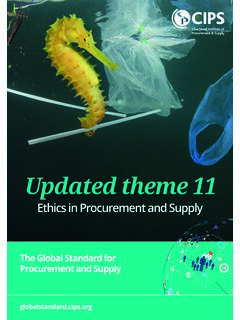Transcription of The Orange Book - GOV.UK
1 Management of Risk principles and ConceptsThe Orange BookTe r mIntentionshalldenotes a requirement: a mandatory element shoulddenotes a recommendation: an advisory elementmaydenotes approvalmightdenotes a possibilitycandenotes both capability and possibilityis/aredenotes a descriptionReferences are shown in square brackets [ ] and listed in Annex 6. The meaning of words is as defined in the Shorter Oxford English Dictionary, except where defined in Annex 5. It is assumed that legal and regulatory requirements shall always be met. Crown copyright 2020 Produced by Mark Ripley, Government Finance FunctionYou may re-use this information (excluding logos) free of charge in any format or medium, under the terms of the Open Government Licence. To view this licence, visit or email: Where we have identified any third-party copyright material you will need to obtain permission from the copyright holders concerned.
2 Alternative format versions of this report are available on request from 1 Scope 3 Purpose 3 Comply or Explain 3 Structure 4 Risk Management principles 5 Section A: governance and Leadership 7 Section B: Integration 11 Section C: Collaboration and Best Information 13 Section D: Risk Management Processes 17 Risk identification and assessment 19 Risk treatment 20 Risk monitoring 20 Risk reporting 21 Section E: Continual Improvement 23 Annex 1 Roles and Responsibilities - Board, Accounting Officer and Audit and Risk Assurance Committee 25 Annex 2 The Three Lines of Defence 29 Annex 3 Questions to Ask 33 Annex 4 Example Risk Categories 37 Annex 5 Definitions and Supportive Concepts 39 Annex 6 References 431 The Orange book | IntroductionIntroductionIn successful organisations, risk management enhances strategic planning and prioritisation, assists in achieving objectives and strengthens the ability to be agile to respond to the challenges faced.
3 If we are serious about meeting objectives successfully, improving service delivery and achieving value for money, risk management must be an essential and integral part of planning and decision-making. While risk practices have improved over time across government, the volatility, complexity and ambiguity of our operating environment has increased, as have demands for greater transparency and accountability for managing the impact of risks. This updated guidance builds on the previous Orange book to help improve risk management further and to embed this as a routine part of how we sector organisations cannot be risk averse and be successful. Risk is inherent in everything we do to deliver high-quality services. Effective and meaningful risk management in government remains as important as ever in taking a balanced view to managing opportunity and risk. It must be an integral part of informed decision-making; from policy or project inception through implementation to the everyday delivery of public services.
4 At its most effective, risk management is as much about evaluating the uncertainties and implications within options as it is about managing impacts once choices are made. It is about being realistic in the assessment of the risks to projects and programmes and in the consideration of the effectiveness of the actions taken to manage these isn t about adding new processes; it is about ensuring that effective risk management is integrated in the way we lead, direct, manage and operate. As an integrated part of our management systems, and through the normal flow of information, an organisation s risk management framework harnesses the activities that identify and manage the uncertainties faced and systematically anticipate and prepare successful responses. Its importance and value to success should not be with all aspects of good governance , the effectiveness of risk management depends on the individuals responsible for operating the systems put in place.
5 Our risk culture must embrace openness, support transparency, welcome constructive challenge and promote collaboration, consultation and co-operation. We must invite scrutiny and embrace expertise to inform decision-making. We must also invest in the necessary capabilities and seek to continually learn from updated guidance has benefited from discussions with stakeholders and practitioners across the public sector and with colleagues from the private sector. We are grateful for their time and their valuable Orange book | Introduction2 ScopeThe document updates the version published in 2004. Like the original, it sets out the main principles underlying effective risk management in all government departments and arm s length public bodies1 with responsibility derived from central government for public funds. This document may be useful to all parts of the UK public sector, as the same principles generally apply, with adjustments for This document is intended for use by everyone involved in the design, operation and delivery of efficient, trusted public services.
6 Its primary audience is likely to be: executive and non-executive members of the board; Audit and Risk Assurance Committee members; risk practitioners; senior leadership; policy leads; and programme and project Senior Responsible Officers (SROs).The board of each public sector organisation should actively seek to recognise risks and direct the response to these risks. It is for each accounting officer, supported by the board, to decide how. The board and accounting officer should be supported by an Audit and Risk Assurance Committee, who should provide proactive support in advising on and scrutinising the management of key risks and the operation of efficient and effective internal controls. Attempting to define a one-size-fits-all approach to managing risks, or to standardise risk management practices, would be misguided because public sector organisations are different sizes, are structured differently and have different document does not set out the procedure by which an organisation should design and operate risk management.
7 It sets out a principles -based approach that provides flexibility and judgement in the design, implementation and operation of risk management, informed by relevant standards[1] and good practice. Where relevant, the reader is directed to other standards and guidance, including related functional and professional standards and codes of practice (see Annex 6). References throughout the document are shown in square brackets [ ].The Management of Risk framework is available through AXELOS2, who manage guides that comprise the recommended best practice for government project delivery and provide advice on their or Explain The document sets out main and supporting principles for risk management in government. In considering the effectiveness of risk management arrangements, assessing compliance with Corporate governance Code[2] requirements, and overseeing the preparation of the governance 1 Executive Agencies, Non Departmental Public Bodies and Non Ministerial AXELOS is a company part owned by the UK government.
8 Their guides are available by subscription or individual Orange book | Introduction3statement, the board shall consider adherence with the main principles , which are mandatory requirements. The supporting principles , which are advisory, should inform their judgements. Departures may be justified if good risk management can be achieved by other main principles are the core of the document. The way in which they are applied should be the central question for a board as it determines how it is to operate in accordance with the Corporate governance Code. Each government organisation is required either to disclose compliance or to explain their reasons for departure clearly and carefully in the governance statement accompanying their annual resource accounts. The requirement for an explanation allows flexibility, but also ensures that the process is transparent, allowing stakeholders to hold organisations and their leadership to core document is structured around Sections (A-E), based on principles that are designed to provide the what and the why , not the how , for the design, operation and maintenance of an effective risk management framework.
9 The principles can be applied within and across departments, arm s length bodies and organisations with linked objectives, and to activity at any level of decision-making. The principles should be used to inform an organisation s approach to risk management and its own more detailed policies, processes and procedures the how . Implementing and improving the risk management framework should support an incremental approach to enhancing risk management culture, processes and capabilities over time, building on what already exists to achieve improved primary roles and responsibilities for the risk management framework are set out in each Section. The responsibilities and expectations of the board, the accounting officer and the Audit and Risk Assurance Committee are also summarised at Annex explanation of, and guiding principles on, the design and operation of the three lines of defence model are provided in Annex 3 contains questions that may assist in assessing how the principles are applied in defining clear responsibilities, promoting the risk culture, developing capabilities and supporting the effectiveness of the risk management common categories or groupings of sources of risk are provided at Annex 4.
10 These may help consider the range of potential risks that may arise; they are not intended to be and supportive concepts are provided at Annex 5 of some terms used throughout this document to explain the scope and intended meaning behind the language 6 contains further details of other standards and guidance referenced throughout the Orange book | Introduction45 The Orange book | Risk Management PrinciplesRisk Management PrinciplesRisk Management FrameworkGovernance and LeadershipIntegrationCollaborationInform ation Insight InsightInformation ConsultationCommunicationContinual ImprovementRisk reportingRisk identif cationand assessmentRisk monitoringRisk treatmentThe risk management framework supports the consistent and robust identification and management of opportunities and risks within desired levels across an organisation, supporting openness, challenge, innovation and excellence in the achievement of objectives.



















![National Environmental Management Act [No. 107 of 1998]](/cache/preview/7/d/b/7/a/8/f/1/thumb-7db7a8f14e43ad607993293a158fde5e.jpg)